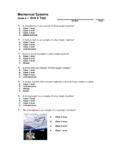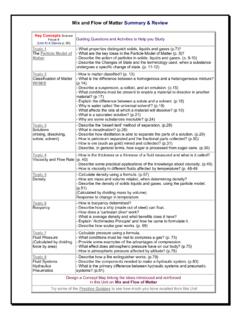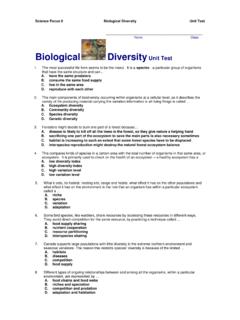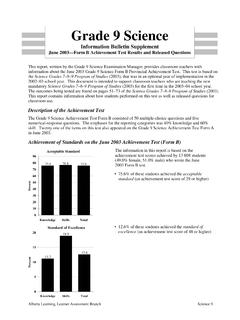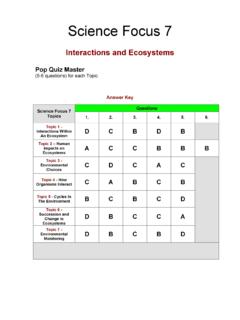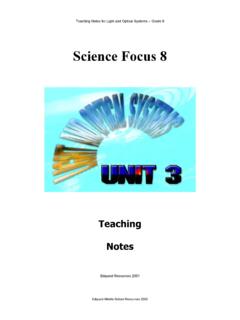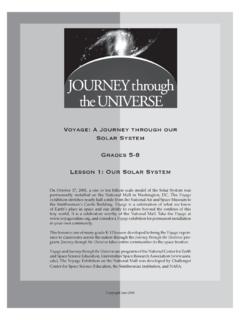Transcription of Science Focus 9 - EDQUEST SCIENCE
1 SCIENCE Focus 9 Space Exploration Notes SCIENCE Focus 9 Unit E Space Exploration Space Link: NASA Topic 1 For Our Eyes Only Frames of Reference What Our Ancestors Saw Ancient Myths Sky Co-ordinates The Stars as a Frame of Reference The Earth-Centred model The Sun-Centred model Topic 2 Stronger Eyes and Better Numbers Telescopes Galileo s Approach to Inquiry Resolving Power Copernicus s Sun-centred Revolution Continues Universal Gravitation Topic 3 The Spectroscope: New Meanings In Light Spectral Lines Spectroscopy: The SCIENCE of Colour Diffraction Gratings Spectroscopy for Astronomers The Doppler Effect An Amazing Tool Topic 4 Bigger and Smarter Telescopes New Discoveries Combining telescopes Adaptive Optics Distance to the Stars Topic 5 What Channel Is This?
2 Radio Telescopes Topic 6 Above the Atmosphere and Under Control Rockets Getting Up There Computers Making Adjustments Global Positioning System ( GPS ) Topic 7 The solar System Up Close The Sun Traveling through The solar System Data Cards for the Inner Planets Data Cards for the Outer Planets Exploring the Outer Planets Voyager Today Topic 8 People In Space Breaking Free of Earth s Gravity The Apollo Program Meeting in Space The Space Shuttle The International Space Station SCIENCE Focus 9 Space Exploration Notes Topic 1 - For Our Eyes Only Frames of Reference A frame of reference is a set of axes of any kind that is used to describe positions or motions of
3 Things. The stars, the Sun and the planets do not rotate around the Earth, but seem to because the Earth is rotating on its axis. The Earth is our fixed frame of reference. To locate positions on Earth, the equator and the prime meridian (latitude and longitude) are the axes used. Reference Frames and Coordinate Systems - Concepts of Earth and Space - What Our Ancestors Saw Objects in the sky have fascinated humans throughout time. The explanations of how these celestial objects came to be are even more fascinating. Ancients developed their ideas of what was happening in the sky and explained it with their frame of reference.
4 The constellations were patterns that seemed to tell stories about people. Stars are not always in the sky at the same time, but change positions over time giving rise to the creation of calendars. The Sun and the Moon have their own pattern or rising and setting the Moon also has phases. Mercury, Venus, Mars, Jupiter, and Saturn were special stars called planets meaning wanderer . - ~ Ancient Myths Myths, folklore and legends were used to explain what ancient people observed in the night sky. First Nations people of the Pacific Northwest believed the night sky was a pattern on a great blanket overhead, which was held up by a spinning world pole resting on the chest of a woman named Stone Ribs.
5 Aboriginal tribes Algonquin, Iroquois and Narragansett believed the constellation Ursa Major was a bear running from hunters. Inuit in the high Arctic used a mitt to determine when seal pups would be born, by holding the mitt at arm s length at the horizon. Ancient Egyptians - The Sun God Ra was carried in a sacred boat across the sky every day. Solstice represents the shortest and longest periods of daylight solstice - shortest period of daylight (Northern hemisphere - Dec. 21) Summer solstice longest period of daylight (Northern hemisphere - June 21) The Ancient Celts set up megaliths, in concentric circles, at Stonehenge to mark the winter and summer solstices.
6 Ancient African cultures set large rock pillars into patterns to predict the timing of the solstices as well. Equinox represents periods of equal day and night equinox occurs in the fall (Northern hemisphere - Sept. 22) Vernal equinox occurs in the spring (Northern hemisphere - Mar. 21) The Mayans of Central America built an enormous cylinder shaped tower, at Chichen Itza, to celebrate the two equinoxes. The Ancient Egyptians built many pyramids and other monuments to align with the seasonal position of certain stars. Aboriginal Peoples of Southwestern Alberta used key rocks, which aligned with certain stars, in their medicine circles.
7 Constellations are the groupings of stars we see as patterns in the night sky. There are 88 constellations and many are explained in Greek Mythology. Asterisms are also groupings of stars, but are not officially recognized as constellations. ~morgan/ SCIENCE Focus 9 Space Exploration Notes Sky Co-ordinates Altitude and Azimuth are calculated from the observer's (the person in blue) position: Altitude tells you "how far above the horizon the object is"; the point straight overhead has an altitude of +90 degrees; straight underneath, an altitude of -90 degrees. Points on the horizon have 0 degree altitudes.
8 An object halfway up in the sky has an altitude of 45 degrees. Azimuth determines "which compass direction it can be found in the sky." An azimuth of zero degrees puts the object in the North. An azimuth of 90 degrees puts the object in the East. An azimuth of 180 degrees puts the object in the South, and one of 270 degrees puts the object in the west. Thus, if you are told that an object is at altitude 30 degrees, azimuth 80 degrees - look a little North of due East, about a third of the way from the horizon to the zenith. Java script applet: Zenith is the position in the sky directly overhead.
9 The path in the sky along which the Sun takes is called the ecliptic. The Celestial Sphere is the name given to the very large imaginary sphere of sky surrounding the Earth. The Stars as a Frame of Reference Ancient cultures tried to explain the motions of the stars and planets, with their frame of reference being the Earth. To track the actual motion of each celestial body in space, you need to use the stars as your frame of reference, instead of the Earth. To do this you would make an observation of which celestial body you are studying and include other stars in relation to it.
10 Make subsequent observations and include those same stars. Over a period of time you would be able to determine in which direction the celestial body you are studying is moving. SCIENCE Focus 9 Space Exploration Notes The Earth-Centred model The Earth was fixed and the center of the solar system with all celestial bodies in space rotating around it. Geocentric Aristotle s model - Assisted by Pythagoras and Euclid The stars were the firmament of fixed stars One of the problems this model faced was trying to explain the retrograde motion (reversal of direction) of Mars, Jupiter and Saturn.
